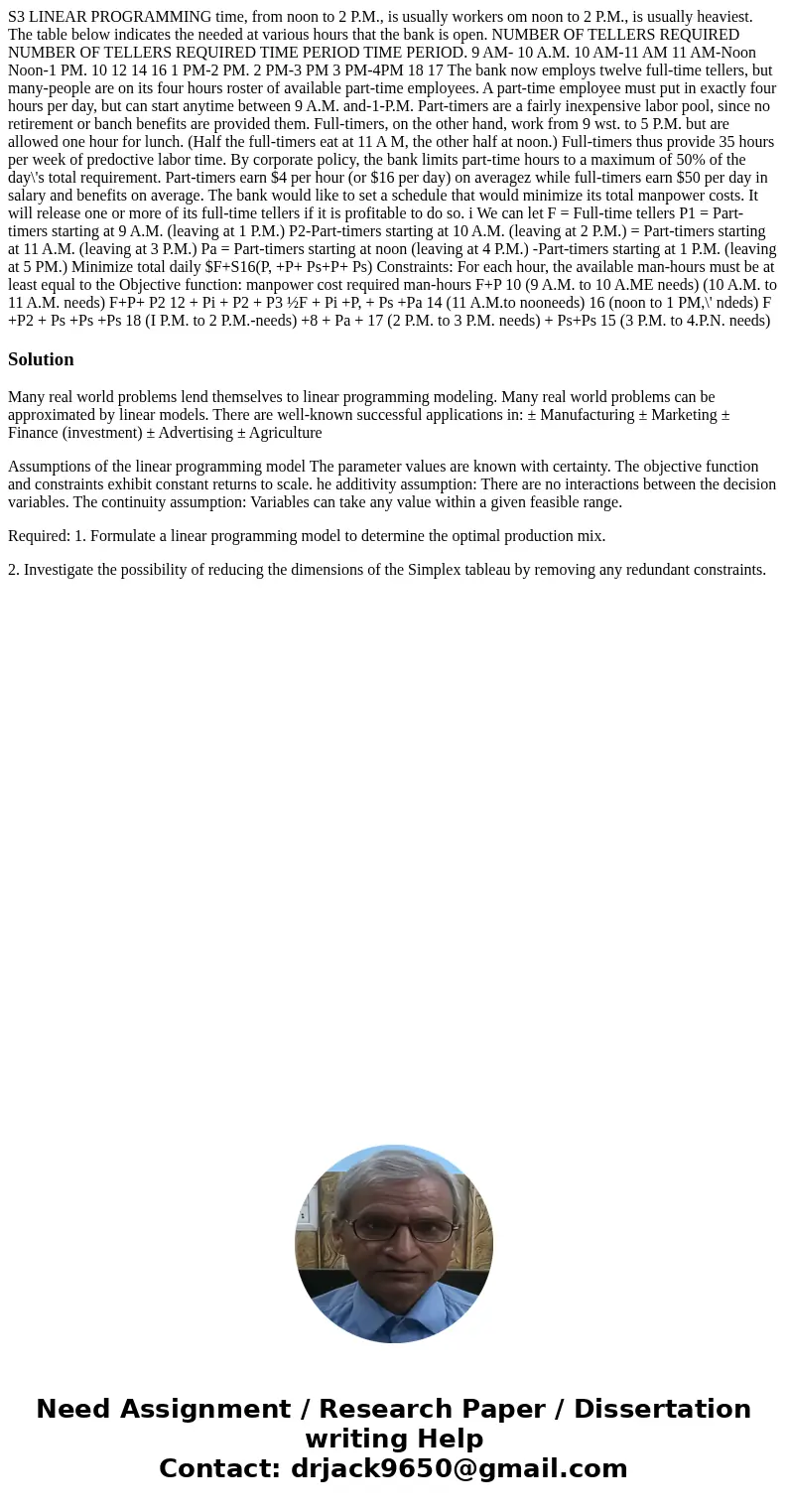S3 LINEAR PROGRAMMING time, from noon to 2 P.M., is usually workers om noon to 2 P.M., is usually heaviest. The table below indicates the needed at various hours that the bank is open. NUMBER OF TELLERS REQUIRED NUMBER OF TELLERS REQUIRED TIME PERIOD TIME PERIOD. 9 AM- 10 A.M. 10 AM-11 AM 11 AM-Noon Noon-1 PM. 10 12 14 16 1 PM-2 PM. 2 PM-3 PM 3 PM-4PM 18 17 The bank now employs twelve full-time tellers, but many-people are on its four hours roster of available part-time employees. A part-time employee must put in exactly four hours per day, but can start anytime between 9 A.M. and-1-P.M. Part-timers are a fairly inexpensive labor pool, since no retirement or banch benefits are provided them. Full-timers, on the other hand, work from 9 wst. to 5 P.M. but are allowed one hour for lunch. (Half the full-timers eat at 11 A M, the other half at noon.) Full-timers thus provide 35 hours per week of predoctive labor time. By corporate policy, the bank limits part-time hours to a maximum of 50% of the day\'s total requirement. Part-timers earn $4 per hour (or $16 per day) on averagez while full-timers earn $50 per day in salary and benefits on average. The bank would like to set a schedule that would minimize its total manpower costs. It will release one or more of its full-time tellers if it is profitable to do so. i We can let F = Full-time tellers P1 = Part-timers starting at 9 A.M. (leaving at 1 P.M.) P2-Part-timers starting at 10 A.M. (leaving at 2 P.M.) = Part-timers starting at 11 A.M. (leaving at 3 P.M.) Pa = Part-timers starting at noon (leaving at 4 P.M.) -Part-timers starting at 1 P.M. (leaving at 5 PM.) Minimize total daily $F+S16(P, +P+ Ps+P+ Ps) Constraints: For each hour, the available man-hours must be at least equal to the Objective function: manpower cost required man-hours F+P 10 (9 A.M. to 10 A.ME needs) (10 A.M. to 11 A.M. needs) F+P+ P2 12 + Pi + P2 + P3 ½F + Pi +P, + Ps +Pa 14 (11 A.M.to nooneeds) 16 (noon to 1 PM,\' ndeds) F +P2 + Ps +Ps +Ps 18 (I P.M. to 2 P.M.-needs) +8 + Pa + 17 (2 P.M. to 3 P.M. needs) + Ps+Ps 15 (3 P.M. to 4.P.N. needs)
Many real world problems lend themselves to linear programming modeling. Many real world problems can be approximated by linear models. There are well-known successful applications in: ± Manufacturing ± Marketing ± Finance (investment) ± Advertising ± Agriculture
Assumptions of the linear programming model The parameter values are known with certainty. The objective function and constraints exhibit constant returns to scale. he additivity assumption: There are no interactions between the decision variables. The continuity assumption: Variables can take any value within a given feasible range.
Required: 1. Formulate a linear programming model to determine the optimal production mix.
2. Investigate the possibility of reducing the dimensions of the Simplex tableau by removing any redundant constraints.

 Homework Sourse
Homework Sourse